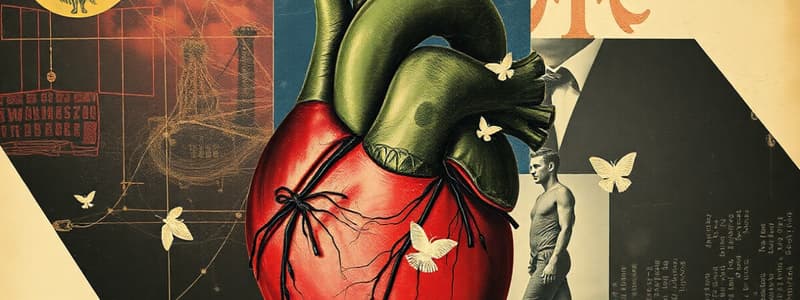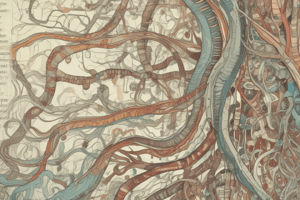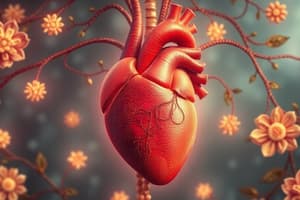Podcast
Questions and Answers
What effect does parasympathetic stimulation have on the heart's depolarization phase?
What effect does parasympathetic stimulation have on the heart's depolarization phase?
- It prolongs the time taken to reach depolarization. (correct)
- It creates a plateau phase.
- It accelerates depolarization.
- It increases conduction velocity.
Which of the following components is primarily responsible for increasing heart rate upon sympathetic stimulation?
Which of the following components is primarily responsible for increasing heart rate upon sympathetic stimulation?
- PKA.
- LTCC.
- cAMP.
- If channels. (correct)
What is the primary effect of parasympathetic stimulation on heart rate?
What is the primary effect of parasympathetic stimulation on heart rate?
- It decreases heart rate. (correct)
- It maintains heart rate.
- It increases heart rate.
- It causes irregular heartbeats.
How does the sympathetic nervous system affect conduction velocity in nodal cells?
How does the sympathetic nervous system affect conduction velocity in nodal cells?
What is the primary consequence of increased If activity in the SA node?
What is the primary consequence of increased If activity in the SA node?
Which neurotransmitter is secreted during parasympathetic stimulation?
Which neurotransmitter is secreted during parasympathetic stimulation?
What role does cAMP play in sympathetic stimulation of nodal cells?
What role does cAMP play in sympathetic stimulation of nodal cells?
What law describes the intrinsic regulation of heart function?
What law describes the intrinsic regulation of heart function?
What happens to the slope of Phase 4 during sympathetic stimulation?
What happens to the slope of Phase 4 during sympathetic stimulation?
What is the effect of sympathetic stimulation on heart rate and contraction force?
What is the effect of sympathetic stimulation on heart rate and contraction force?
Which protein is associated with the positive chronotropic effect in nodal cells?
Which protein is associated with the positive chronotropic effect in nodal cells?
Which channel is affected by acetylcholine during parasympathetic control?
Which channel is affected by acetylcholine during parasympathetic control?
How does the activity of the If channel affect the heart rate?
How does the activity of the If channel affect the heart rate?
Which effect best describes the (-) dromotropic effect?
Which effect best describes the (-) dromotropic effect?
What is primarily lowered during parasympathetic stimulation?
What is primarily lowered during parasympathetic stimulation?
What role does norepinephrine play in sympathetic stimulation?
What role does norepinephrine play in sympathetic stimulation?
Which type of receptors are primarily involved in parasympathetic control on nodal cells?
Which type of receptors are primarily involved in parasympathetic control on nodal cells?
Which neurotransmitters are involved in sympathetic control of nodal cells?
Which neurotransmitters are involved in sympathetic control of nodal cells?
What effect does sympathetic stimulation have on cAMP levels in nodal cells?
What effect does sympathetic stimulation have on cAMP levels in nodal cells?
What is the physiological response when the heart's K+/ACh channel activity increases?
What is the physiological response when the heart's K+/ACh channel activity increases?
What effect does sympathetic stimulation have on the heart's conduction velocity?
What effect does sympathetic stimulation have on the heart's conduction velocity?
Which type of agents positively affect contractility in cardiac contractile cells?
Which type of agents positively affect contractility in cardiac contractile cells?
What is the primary factor that determines heart rate?
What is the primary factor that determines heart rate?
Which type of effect is associated with changes in heart rate?
Which type of effect is associated with changes in heart rate?
What is the effect of a positive dromotropic agent on conduction velocity through the AV node?
What is the effect of a positive dromotropic agent on conduction velocity through the AV node?
Which physiological process increases stroke volume during sympathetic stimulation?
Which physiological process increases stroke volume during sympathetic stimulation?
What effect does sympathetic stimulation exert on the duration of ventricular diastole?
What effect does sympathetic stimulation exert on the duration of ventricular diastole?
How does the intrinsic regulation of the heart differ from extrinsic regulation?
How does the intrinsic regulation of the heart differ from extrinsic regulation?
Which protein inhibits the SERCA2 pump in cardiac contractile cells?
Which protein inhibits the SERCA2 pump in cardiac contractile cells?
What is the relationship between venous return and stroke volume during sympathetic activation?
What is the relationship between venous return and stroke volume during sympathetic activation?
Flashcards
Intrinsic heart regulation
Intrinsic heart regulation
Heart function regulated by its inherent characteristics, not external factors like nerves or hormones.
Extrinsic heart regulation
Extrinsic heart regulation
Heart function regulated by nerves and hormones.
Starling's Law of the Heart
Starling's Law of the Heart
The heart's ability to adjust its output based on the volume of blood entering it.
Parasympathetic stimulation
Parasympathetic stimulation
Signup and view all the flashcards
Sympathetic stimulation
Sympathetic stimulation
Signup and view all the flashcards
Vagus nerve
Vagus nerve
Signup and view all the flashcards
Acetylcholine
Acetylcholine
Signup and view all the flashcards
Epinephrine/Norepinephrine
Epinephrine/Norepinephrine
Signup and view all the flashcards
Chronotropic effect
Chronotropic effect
Signup and view all the flashcards
Cardiac Nerves
Cardiac Nerves
Signup and view all the flashcards
What does a positive chronotropic effect do?
What does a positive chronotropic effect do?
Signup and view all the flashcards
What does a negative chronotropic effect do?
What does a negative chronotropic effect do?
Signup and view all the flashcards
What does a negative dromotropic effect do?
What does a negative dromotropic effect do?
Signup and view all the flashcards
What is the effect of sympathetic stimulation on cardiac contractile cells?
What is the effect of sympathetic stimulation on cardiac contractile cells?
Signup and view all the flashcards
What is an inotropic effect?
What is an inotropic effect?
Signup and view all the flashcards
What is the relationship between stroke volume and heart rate?
What is the relationship between stroke volume and heart rate?
Signup and view all the flashcards
How does venous return affect stroke volume?
How does venous return affect stroke volume?
Signup and view all the flashcards
How does sympathetic innervation and epinephrine influence cardiac contractility?
How does sympathetic innervation and epinephrine influence cardiac contractility?
Signup and view all the flashcards
LTCC Activity in Phase 0
LTCC Activity in Phase 0
Signup and view all the flashcards
Parasympathetic Control on the Heart
Parasympathetic Control on the Heart
Signup and view all the flashcards
Sympathetic Control on Nodal Cells
Sympathetic Control on Nodal Cells
Signup and view all the flashcards
If Activity (funny current)
If Activity (funny current)
Signup and view all the flashcards
Phase 4 Slope
Phase 4 Slope
Signup and view all the flashcards
Membrane Potential
Membrane Potential
Signup and view all the flashcards
Heart Rate (HR)
Heart Rate (HR)
Signup and view all the flashcards
Threshold (VT)
Threshold (VT)
Signup and view all the flashcards
Study Notes
Regulation of Heart Function
- Intrinsic regulation arises from the normal functioning of the heart, independent of neural or hormonal control.
- Starling's Law of the Heart is a key concept in intrinsic regulation.
- Extrinsic regulation involves controlling the heart via neural and hormonal signals.
- Parasympathetic stimulation, mediated by the vagus nerve, slows heart rate by releasing acetylcholine.
- Sympathetic stimulation, via cardiac nerves, increases heart rate and contractility by releasing epinephrine and norepinephrine.
- Cardiac innervation: Parasympathetic and sympathetic pathways regulate the heart's rhythm and contractility.
Parasympathetic Control on Nodal Cells
- Parasympathetic activity reduces the slope of phase 4, hyperpolarizing nodal cells and slowing heart rate.
- It increases potassium channel activity and thus, reduces heart rate.
- This decreases the rate of spontaneous depolarization (phase 4) and prolongs the time to reach threshold.
- The slowed depolarization decreases heart rate and conduction velocity.
Sympathetic Control on Nodal Cells
- Sympathetic activity increases the slope of phase 4, speeding up the heart rate.
- It enhances the activity of the If channel, leading to a faster rate of spontaneous depolarization.
- This faster depolarization leads to faster heart rate and conduction velocity.
Extrinsic Regulation: Parasympathetic Control
- Parasympathetic stimulation causes a hyperpolarized state.
- The depolarization phase becomes slower compared to the normal heart rate.
Extrinsic Regulation: Sympathetic Control
- Sympathetic stimulation causes a steeper and faster depolarization phase.
Types of Effects: Chronotropic Effect
- Chronotropic effect relates to changes in heart rate.
- Increased sympathetic stimulation leads to an increase in heart rate (positive chronotropic).
- Parasympathetic stimulation leads to a decrease in heart rate (negative chronotropic).
Types of Effects: Dromotropic Effect
- Dromotropic effects involve changes in conduction velocity across the heart.
- Sympathetic stimulation speeds up conduction.
- Parasympathetic stimulation slows conduction.
Types of Effects: Inotropic Effect
- Inotropic effects modify cardiac contractility.
- Positive inotropic effect increases contractility (eg. Epinephrine, Norepinephrine).
- Negative inotropic effect decreases contractility (eg. certain chemicals).
Stroke Volume and Heart Rate
- Stroke volume is the volume pumped by the heart with each beat.
- Heart rate is the number of beats per minute.
- Cardiac output is the product of stroke volume and heart rate.
- Factors affecting stroke volume include contractility, end-diastolic volume, and venous return.
- Factors affecting heart rate include sympathetic and parasympathetic inputs.
Wiggers Diagram
- A graphical representation of the cardiac cycle, showing relationships between pressure, volume, and electrical activity.
- The diagram illustrates the phases of the cardiac cycle and the associated changes in ventricular pressure, volume, and electrical activity.
- Shows the relationship between heart sounds, electrical signals, pressure, and volume changes within the heart during one cardiac cycle.
Studying That Suits You
Use AI to generate personalized quizzes and flashcards to suit your learning preferences.




